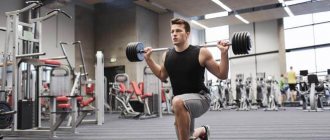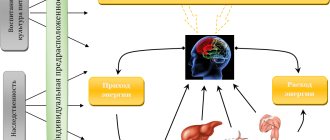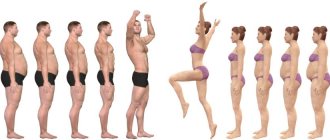Last to leave, first to arrive
Everyone has problem areas in their body - both professional bodybuilders and just people who train. Yes, yes, you know what I'm talking about: those stubborn, annoying folds in the lower abdomen.
The fat in these areas appears immediately after you stop your diet and is always the last to go when you are on the path to building a better version of yourself. Let's talk about how to remove fat from problem areas, but first let's figure out why it so stubbornly doesn't want to leave some places?
What is the simplest lifting of problem areas?
Anti-aging creams and masks are the simplest lifting method. Such products differ in the time of use (day and night), consistency (thick, light, gels). These creams and masks must contain hyaluronic acid, antioxidants, collagen, fats and vitamins.
Compositions made from natural ingredients also have a slight tightening effect. These products also go well with innovative cosmetic procedures. To prepare the simplest and most effective masks, you will need products familiar to everyone: 1) oatmeal and olive oil; 2) cucumber, lemon juice and white clay; 3) strawberries, egg white and 2-3 drops of apricot oil.
Recommended articles on the topic:
- Thermal detoxification: lightness of the body and clear skin
- Lipolytic therapy: indications, contraindications, stages of the procedure
- Weight correction: everything you need to know about the procedure
The nature of fat in problem areas
It would seem that fat is fat, but this is not entirely true. There are different types of fat tissue in the body, and they respond differently to your lifestyle, exercise, and diet.
There is brown adipose tissue, the “good” fat that helps your body generate heat and is even known to help you burn more calories. Visceral fat surrounds the organs in the abdominal cavity, while intermuscular fat accumulates in and around muscle fibers.
When we talk about stubborn fat, we most often mean subcutaneous fat. Such fat has a higher density of alpha receptors, it is more sensitive to insulin and has a worse blood supply compared to fat that is lost quickly.
When fat is burned, including stubborn fat, hormone-sensitive lipase is activated by hormones, breaking down triglycerides into glycerol and fatty acids. Next, fatty acids are oxidized under the influence of oxygen, and breakdown products are excreted through sweat, urine, feces, and even through respiration.
Fat in problem areas essentially burns at a slower pace than other types. The reason lies in such physically active substances as catecholamines. The task of these substances is to bind to receptors (alpha and beta receptors) in adipose tissue, which in turn affects the rate of fat burning. Beta receptors promote fat burning, and alpha receptors promote fat storage.
In other words, alpha receptors, which are responsible for storing fat, slow down the action of hormone-dependent lipase, which is the main enzyme in the body responsible for breaking down fat.
So in order to burn fat, you need to increase the number of beta receptors and decrease the number of alpha receptors. There are several ways to do this: improving blood flow and insulin sensitivity will help activate beta receptors to help burn fat in the lower abdomen and those problem areas. What needs to be done for this will be described in this article.
Where do they come from?
Another name for problem areas is “fat traps,” places in which a layer of fat remains even after losing weight. Usually they are the last to “give up” - when the weight approaches a critical level that threatens health.
They lose fat, but not actively and willingly, like other places. Why does this happen? Let's first find out how fat is used by our body and by what principle it is deposited in these places. The following is an excerpt from the very cool book “Charming Intestines”.
Of all nutrients, fats (lipids) are the most valuable and effective substance. When fat molecules break, interatomic bonds release enormous amounts of energy. When splitting 1 g. Fat releases 2 times more energy compared to carbohydrates or proteins.
The body uses lipids to form sheaths around nerve fibers, much like insulation for wires. Thanks to the presence of such shells, we can quickly generate thoughts. Some important hormones are fatty in nature, and, after all, fat molecules are part of the membranes of our cells.
That’s why fat is protected in this way and is not used up at the first need. In the event of famine, which our body has experienced more than once during evolution, every gram of fat increases the chance of survival.
Hormones are different in different situations. When our body prepares for stress (fight or flight) it is adrenaline. When we are hungry and the blood sugar level is low - glucagon. When we are very, very hungry, and even endure heavy physical or psycho-emotional stress - cortisol. At night, growth hormone (somatotropin) is used to supply energy to construction processes. And so on.
This ability to command the breakdown of fats is called lipolytic ability. Although hormones with lipolytic abilities move throughout the body, fat will be lost unevenly in different places . This will depend on the blood supply to the tissues (their capillarization) and on the number and activity of cellular receptors.
Adipose tissue in places provided by evolution for storing fat (thighs, buttocks, abdomen) will store it more actively and dissolve more slowly . In places where it is not very convenient for the body to store and carry fat, less fat will be stored and it will be broken down faster.
In fact, fat cells are not evenly distributed throughout the body, but even slightly chaotically - there are more here, less here. There is, of course, a scientific explanation for this. In particular, our fat cells are not only inert “storage tanks” for excess energy. They are endocrine glands that send/receive signals from the rest of the body.
In other words, our fat cells “speak” to our body, and the body responds to them. This occurs through hormones and receptor systems.
To lose fat, you need to create a demand for energy and release special hormones that send a signal to fat cells. The latter receive this hormonal signal through special receptors, which will be discussed below.
In response to which the fat cell (which does not “break down” or “burn” anywhere - it remains so that later, when you eat more than you need, you can re-absorb the fat) releases fatty acids into the bloodstream .
The free fatty acids must then be transported to the working muscles where they are burned for energy. Here is such a seemingly simple scheme. In it, the very receptors that transmit the signal are extremely important to us.
They exist in two types: beta 1 and alpha 2 receptors:
- Beta 1 is a receptor that activates the hormone sensitive lipase, an enzyme that breaks down fat, allowing it to be released into the bloodstream for subsequent combustion.
- Alpha 2 - receptors that block fat-digesting enzymes in fat cells and promote the formation of fat in the body.
It has been proven that in the lower part of the body, women have 9 times more alpha-2 receptors (these are hips, legs, knees, buttocks) than beta-2 (well, of course, who would doubt it); men have the same problem with the abdominal area - therefore, many males have the so-called on their stomach. “lifebuoy” for fairly thin legs, shoulders, and arms.
The sensitivity of fat in different places, forgive the tautology, is different. Fat breakdown occurs more actively in adipose tissue located in the chin, neck, supraclavicular and subclavian fossae. The nastiest and most persistent fat is that found on the stomach and buttocks.
It has been established that fat cells in these places accumulate fat 6 times more and give off fat 6 times less when losing weight, which makes the fight against problem areas so exhausting. It happens that a person has already lost a lot of weight to the point of exhaustion of the upper body, but the conditional “fat knees” still remain.
Alas, the whole problem is that in this particular place the number of alpha-2 is greater than the number of beta-1 receptors, so the fat cells in this place are more willing to store fat and practically ignore your desire to part with it.
This is determined not only by gender, genetics also plays a role here (so these “oh, well, your hips look like your grandmother” are completely justified) and your individual special structure.
This is interesting: estrogen is a female sex hormone, the maximum concentration of which is observed during pregnancy. It stimulates the growth and division of fat cells. The appearance of flanks and fat deposits in the abdomen and thighs may indicate an increase in estrogen levels - get tested for hormones!
By the way, it is generally more difficult for women to lose weight - women’s metabolism, unlike men’s, is tuned to maintaining weight and protecting against fat loss. add to this nasty receptors and a smaller number of muscles and we get a classic woman who has been fighting with her sides or riding breeches for half her life.
Of course, some are lucky and their receptors are distributed in such a way that, for example, there is more alpha 2 in the buttocks and chest, and beta 1 in the stomach, riding breeches and legs. But what can you do, life is generally an unfair thing.
Method 1: Train on an empty stomach
Fasting is abstaining from consuming any calorie-containing foods for a short period of time. Working out on an empty stomach is the most effective way to get rid of stubborn fat from different areas of the body.
I'm not talking about abstaining from food for a day and I'm not encouraging you to torture yourself with hunger. The idea is to not eat for 16-18 hours and then eat for the remaining 8-10 hours. This is a proven method that allows you to transfer fat cells into the metabolic furnace, where they will be utilized. How does it work?
Fasting makes it easier to achieve a calorie deficit
Intermittent fasting allows busy people to maintain a calorie deficit. There are other benefits of fasting, but 80% of the benefits of fasting are in its impact on lifestyle: if you consume fewer calories than you expend and do so consistently, you will burn more fat.
Fasting may increase growth hormone production
The production of growth hormone is the most important factor influencing muscle growth and fat burning. The decrease in growth hormone production with age is the reason why fat burning slows down. There is evidence that fasting increases the production of growth hormone, and therefore accelerates fat burning.
Fasting increases insulin sensitivity
Insulin sensitivity, or lack thereof, plays a critical role in fat storage. Although most of the research on intermittent fasting has focused on diabetics, the findings can be applied to healthy people as well. A 2005 study led by Halberg et al found that intermittent fasting improved insulin sensitivity in healthy people.
Fasting helps control appetite
I would, however, not recommend training on an empty stomach if you want to maintain muscle while losing weight or building muscle, fighting stubborn fat in problem areas is a war of attrition.
The use of training on an empty stomach is justified in two cases:
First, according to Gzhested's research, blood flow to problem areas such as the lower abdomen improves during fasting. When blood supply increases, catecholamines can attack fat cells, activate them and burn fat faster.
Second, based on personal preference, fasted training is a double whammy for fat loss, especially when combined with cardio. For most iron enthusiasts, doing cardio to burn fat can improve fat oxidation simply because we rarely do cardio. If you want to be extremely lean (7% and below), then fasted cardio is what can help you.
One drawback is that muscle catabolism may increase with the fasted training method. For this reason, keep this trump card in your pocket and only play it when you are already quite dry and want to achieve extreme relief. Do not use this method if your main goal is muscle growth.
Create a fat-burning workout program
Your task is to keep your heart rate in the fat burning zone (55-65% of the conditional maximum). If you exercise without a heart rate monitor, go by how you feel. It shouldn't be very difficult for you, but you don't need to feel sorry for yourself.
Do 2-3 cardio workouts per week
The easiest way to keep your heart rate in the desired zone is to run at a moderate pace for at least 30 minutes. Actually, it can be an exercise bike, a treadmill, an ellipse, the main thing is to monitor your heart rate. But warm-up running before training does not count. But you can’t limit yourself to just running, because the body also needs a strong muscle corset. We wrote about it here.
Strength train all muscle groups
Yes, you are unhappy with your stomach. But in an hour of crunches you will only spend 150-250 kcal. And for an hour of training the whole body, working on the muscles of the legs, chest, back and ill-fated abs - from 500 kcal. There should also be three such workouts per week. And exercise, again, mainly in the fat burning pulse zone.
Characteristics of a fat burning workout Weight: 30-40% of one-time maximum Number of repetitions: 15-20 (abs - 30-50) Rest between sets: 30-60 seconds Rest between exercises: up to 90 seconds
If you need more time to rest, reduce the weight of the weight.
Work on the problem area
This, as you already know, will not increase fat burning in this particular area, but the problem area can be caused not only by a general high percentage of fat, but also by muscle weakness. For example, triceps or abdomen. They need to be strengthened, like all other muscles.
Method 2: Specialized nutrition
No supplement can independently turn on fat burning mode. First, you should build a diet and exercise routine. But I would be lying if I said that supplements are not an important factor in eliminating problem areas. You need three factors - training (flame), caloric deficit (fuel), and nutritional supplements will serve as the ignition spark, accelerating the combustion process.
The best way to get more beta receptors through specialized nutrition is to use supplements or eat foods that will increase the amount of fat-burning hormones that bind to beta receptors.
Here's what you should use for this:
- Capsaicin. Capsaicin is the ingredient in chili peppers that gives them their heat. It increases fat burning by accelerating metabolic processes and increasing the level of fat-burning hormones.
- Yohimbine. Yohimbine and products containing it improve fat burning by neutralizing alpha receptors in adipose tissue. If you combine training, fasting and taking foods with yohimbine, fat burning, especially in problem areas, will accelerate.
- Green tea extract. Drinking green tea has a similar effect. Green tea has a thermogenic effect, which has an effect on fat burning.
- Caffeine. Your morning cup of coffee can work wonders if the coffee is really strong. Caffeine binds to fat cells and accelerates lipolysis.
- Conjugated linoleic acid (CLA), which inhibits lipoprotein lipase, an enzyme responsible for fat storage. As a result of consuming CLA, fat tissue becomes better available for use instead of being stored. In addition, CLA has powerful anti-inflammatory effects, improving joint and overall health during the diet.
Method 3: Training aimed at activating fat burning
Even though every trainer on the planet seems to be talking about this, I’ll say it again: you can speed up fat loss in problem areas. How to do this?
To begin with, you need to be fairly thin already, otherwise you won't see a difference. You create a calorie deficit and perform special workouts that activate blood circulation in problem areas.
This is exactly how it works: you improve blood flow to stubborn areas, increase catecholamine activity and ensure the breakdown of fat molecules. Through training, fat is utilized.
How to achieve this? There is a formula: alternate exercises that warm up your problem areas for 45-60 seconds (for example, abdominal exercises) with high-intensity exercises, such as sprinting for 30-45 seconds.
Method 4: Find the best diet for you
When it comes to fat loss, the formula for success is very simple:
Calories burned > calories eaten = fat burned
Fat burning requires following this formula. You must burn more calories than you consume each day in order to see quick results. A calorie deficit created through exercise, diet, and healthy hormone levels will cause fat to burn and get you into good physical shape.
A more precise formula may be too complicated, so to calculate your daily calorie consumption, you can use a simple calculation:
Body weight (in kg) x 33 = your daily calorie intake
This formula is not perfect, but its results are pretty close to more complex ones, and it also gives a good starting value on which to start.
Let's say you weigh 90 kg, therefore:
90 kg. x 33 ≈ 3000 kcal.
This value shows how many calories you need to consume to meet your current needs.
Now let's move on to the more entertaining part: counting the number of calories needed in order to lose weight:
Reducing fat levels in problem areas requires an aggressive approach. 20 - 30% is a suitable value. A 2015 study led by Houvinen determined that trained male athletes can successfully lose weight without significantly reducing testosterone production or reducing performance when maintaining a 25% caloric deficit. Start with a 20% caloric deficit, track your progress and increase this to 30% if you reach a plateau.
Let's say you want to achieve a calorie deficit of 20%, therefore, you need to multiply your daily calorie intake by 0.8. 3000 x 0.8 = 2400 kcal.
Exercises for losing weight in problem areas
Let's take specific areas and look at how to remove excess weight from them.
Beautiful belly
The complex of physical activities is focused on the abdominal muscles, performed in a supine position, in a plank, or standing.
When lying on your back, use your own body weight:
- Straight and oblique crunches (lifting the body).
- Extended leg raises (possibly with rotation), scissors, bicycle.
- Boat.
Training standing or in a plank is recommended for those who experience back pain or have spinal injuries.
Options for reducing waist size:
- Traditional plank.
- Plank with arm and leg raises (for example, the “Spider” exercise, in which the bent right leg is stretched to the right elbow, then the left leg, respectively).
- Side plank.
- Reverse (face up) with legs abducted.
Working out the abdominal muscles while standing occurs by lifting the legs to the chest, turning, and bending to the sides. In this position, the load of body weight is not enough; trainers advise using dumbbells
.
The most effective scheme of the complex: 3-5 exercises in 3 sets of 20-30 repetitions.
After childbirth, a vacuum helps to cope with a bulging “apron”, which returns the internal organs of the abdominal region to their original position. Option for beginners - on the back:
- exhale slowly;
- deep breath;
- maximum exhalation;
- holding your breath while pulling the abdominal muscles towards the spine;
- inhalation with fixation of position (duration is determined individually);
- gradual relaxation.
Perform 10-15 approaches with breaks 2 times a day in front of a mirror to control the movements.
Training is contraindicated for diseases of the stomach, intestines, cardiovascular system, and during pregnancy. Finish the exercise if you feel dizzy or nauseous.
Firm thighs and buttocks
Technique for local work on “ears” and other imperfections:
- Squats and half-squats (dynamic, static, that is, with a delay of 20-40 seconds).
- Swing your legs back, to the side.
- Lunges.
A small ball squeezed between your knees will make your thighs “burn.” To work the inner thighs, repeat 20 times.
If a fitball is used, it is placed between the feet. In this version, you can raise and lower your outstretched legs, tilt them to the sides, firmly fixing the ball.
Toned calf muscles, slender knees
The purpose of the exercises for women is to tighten flabby calves, and for men to create sculpted volume. In order not to go beyond burning excess fat, you should not train your calf muscles more than twice a week.
.
Standing, sitting, or using a platform are suitable for calf raises.
Thin hands
Work on slimming your arms:
- Push-ups in any variant (from a support, floor, wall).
- Raising arms with dumbbells.
- Raising arms with weights from a lying position (delayed for 5 seconds).
The technique of execution is quite simple, so the exercises are combined with working out the hips (lunges with dumbbells in hands). Bonus - strengthening the chest muscles.
Macronutrient content
Our diet, based on 2400 kcal per day, should consist of:
- 35% protein
- 35% carbohydrates
- 30% fat
Let's calculate the amount of each macronutrient based on percentage values:
- 35% protein would be 210 grams. 2400 kcal x 0.35 = 840 kcal. In order to determine how much this will be in grams, you need to divide this value by 4 (since one gram of protein contains 4 kcal). Thus we get a value of 210 g. protein per day.
- 35% carbohydrates will also be 210 g. Here's the calculation: 2400 kcal x 0.35 = 840 kcal. A gram of carbohydrates contains 4 kcal, therefore, divide 840 by 4 and get 210 grams. carbohydrates.
- 30% fat would be 80 grams. Calculation: 2400 kcal x 0.30 = 720 kcal. Divide this value by 9 (one gram of fat contains 9 kcal) and we get 80 grams of fat per day.
It's more important to stick to the correct calorie and protein intake than it is to stick to the exact carbohydrate and fat intake. The amount of carbohydrates can be adjusted based on personal preference.
Summarize:
- 2400 kcal. per day;
- 210 gr. squirrel;
- 210 gr. carbohydrates;
- 80 gr. fat










